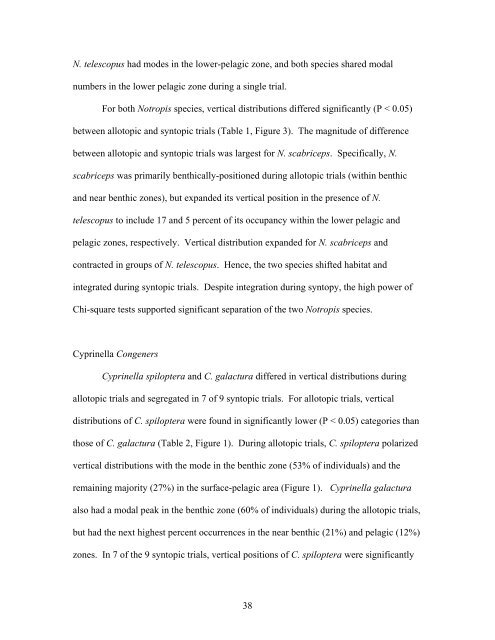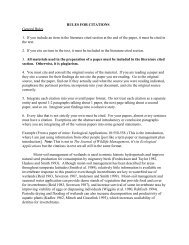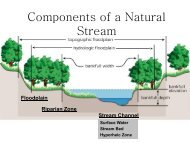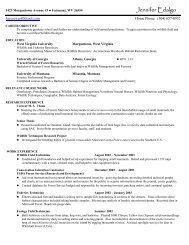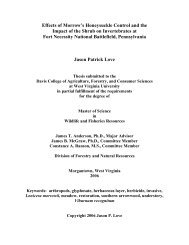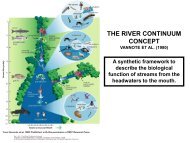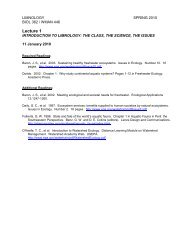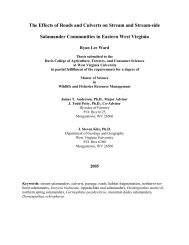An Experimental Study of Vertical Habitat Use and Habitat Shifts in ...
An Experimental Study of Vertical Habitat Use and Habitat Shifts in ...
An Experimental Study of Vertical Habitat Use and Habitat Shifts in ...
You also want an ePaper? Increase the reach of your titles
YUMPU automatically turns print PDFs into web optimized ePapers that Google loves.
N. telescopus had modes <strong>in</strong> the lower-pelagic zone, <strong>and</strong> both species shared modal<br />
numbers <strong>in</strong> the lower pelagic zone dur<strong>in</strong>g a s<strong>in</strong>gle trial.<br />
For both Notropis species, vertical distributions differed significantly (P < 0.05)<br />
between allotopic <strong>and</strong> syntopic trials (Table 1, Figure 3). The magnitude <strong>of</strong> difference<br />
between allotopic <strong>and</strong> syntopic trials was largest for N. scabriceps. Specifically, N.<br />
scabriceps was primarily benthically-positioned dur<strong>in</strong>g allotopic trials (with<strong>in</strong> benthic<br />
<strong>and</strong> near benthic zones), but exp<strong>and</strong>ed its vertical position <strong>in</strong> the presence <strong>of</strong> N.<br />
telescopus to <strong>in</strong>clude 17 <strong>and</strong> 5 percent <strong>of</strong> its occupancy with<strong>in</strong> the lower pelagic <strong>and</strong><br />
pelagic zones, respectively. <strong>Vertical</strong> distribution exp<strong>and</strong>ed for N. scabriceps <strong>and</strong><br />
contracted <strong>in</strong> groups <strong>of</strong> N. telescopus. Hence, the two species shifted habitat <strong>and</strong><br />
<strong>in</strong>tegrated dur<strong>in</strong>g syntopic trials. Despite <strong>in</strong>tegration dur<strong>in</strong>g syntopy, the high power <strong>of</strong><br />
Chi-square tests supported significant separation <strong>of</strong> the two Notropis species.<br />
Cypr<strong>in</strong>ella Congeners<br />
Cypr<strong>in</strong>ella spiloptera <strong>and</strong> C. galactura differed <strong>in</strong> vertical distributions dur<strong>in</strong>g<br />
allotopic trials <strong>and</strong> segregated <strong>in</strong> 7 <strong>of</strong> 9 syntopic trials. For allotopic trials, vertical<br />
distributions <strong>of</strong> C. spiloptera were found <strong>in</strong> significantly lower (P < 0.05) categories than<br />
those <strong>of</strong> C. galactura (Table 2, Figure 1). Dur<strong>in</strong>g allotopic trials, C. spiloptera polarized<br />
vertical distributions with the mode <strong>in</strong> the benthic zone (53% <strong>of</strong> <strong>in</strong>dividuals) <strong>and</strong> the<br />
rema<strong>in</strong><strong>in</strong>g majority (27%) <strong>in</strong> the surface-pelagic area (Figure 1). Cypr<strong>in</strong>ella galactura<br />
also had a modal peak <strong>in</strong> the benthic zone (60% <strong>of</strong> <strong>in</strong>dividuals) dur<strong>in</strong>g the allotopic trials,<br />
but had the next highest percent occurrences <strong>in</strong> the near benthic (21%) <strong>and</strong> pelagic (12%)<br />
zones. In 7 <strong>of</strong> the 9 syntopic trials, vertical positions <strong>of</strong> C. spiloptera were significantly<br />
38


